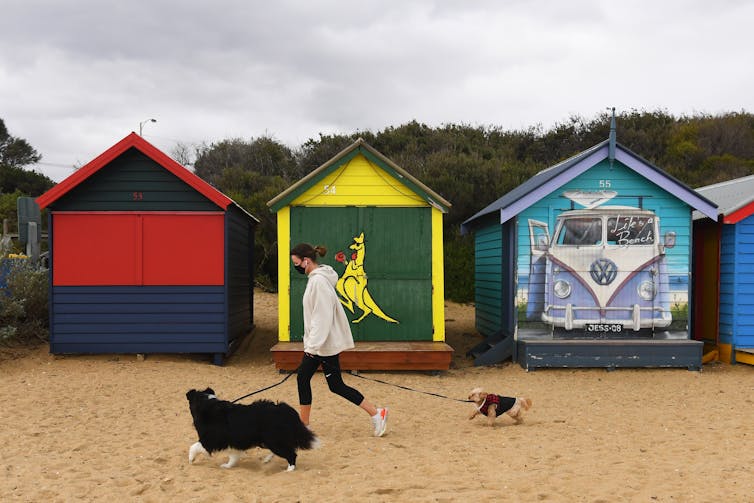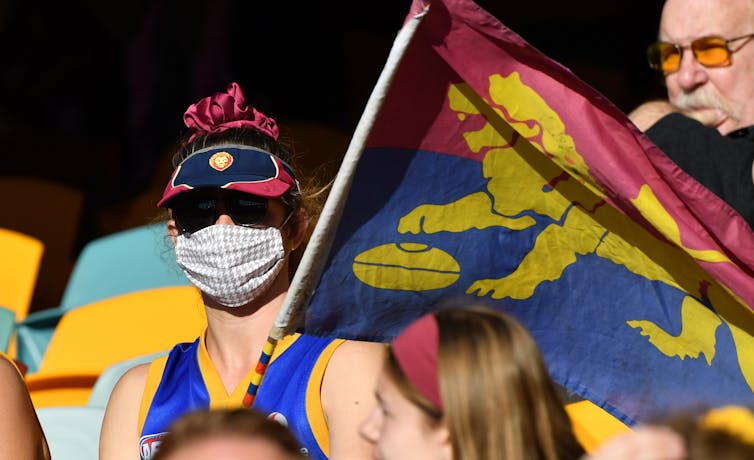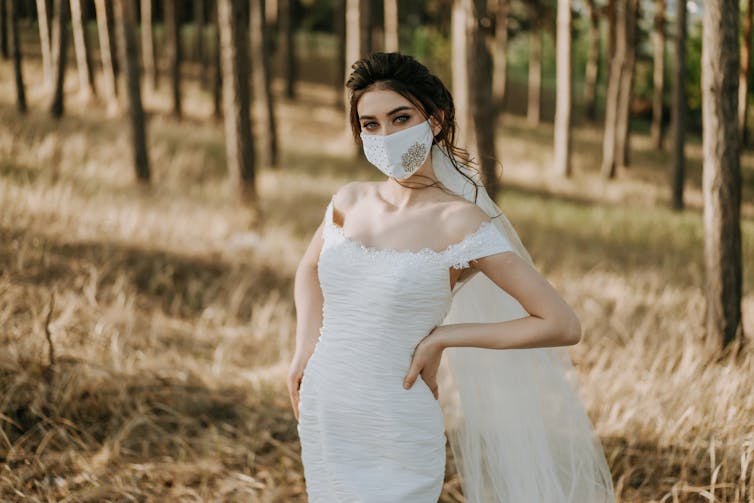From scary pumpkins to bridal bling, how masks are becoming a normal part of our lives in Australia
A year ago, face masks were a rarity in Australia. But social researchers say there is evidence of a growing acceptance of this simple object.
A year ago, face masks were a rarity in Australia. But social researchers say there is evidence of a growing acceptance of this simple object.
On Halloween this Saturday, it won’t be just trick-or-treating children who are wearing spooky costumes. Adults handing out sweet treats may also be sporting Halloween-themed face masks, which are now readily available online.
Come the festive season, you will also be able to wear a Christmas-themed face mask as you unwrap gifts with family and friends. You may even find some handmade cloth masks as part of your present haul.
As social researchers completing a book on face masks during COVID, we are keeping a close eye on the social trends and popular culture related to these simple objects.
We have observed increasing evidence masks are becoming normalised and part of everyday life, noting they are currently compulsory in Victoria. They are now commonly seen in public places around Australia and a thriving industry has sprung up to cater for every possible face mask need.
Pre-COVID, face masks are commonly worn in parts of Asia for a variety of reasons — including protection from pollution and the sun, personal privacy, and warding off seasonal flu and the common cold.
But in countries such as Australia, masks were rarely seen. A year ago, few Australians would not have given much thought to the humble surgical face mask, or ever considered buying, much less wearing one. Face masks were only for healthcare professionals.

But with the arrival of the COVID-19 pandemic, the face mask has taken on a new significance. Even though we were initially advised against wearing them to reduce the spread of coronavirus, state health authorities in NSW and Queensland now recommend face masks should be used in situations where physical distancing is not possible.
The Victorian government has also mandated the use of face coverings for its citizens since the second lockdown in August. Earlier this month, fitted face masks (not bandanas or scarves) were made compulsory every time people leave their homes.
As Victoria opened up earlier this week, Premier Daniel Andrews noted, “masks need to be with us across the whole state for some time to come”.
In Australia, we haven’t seen the intense political debates and activism around face masks that have emerged in the United States. Compared with the US, Australians tend not to see preventive health as a political issue. In fact, there is evidence of a growing acceptance face masks are becoming part of our everyday lives.
Australian Bureau of Statistics figures show the proportion of Australians wearing face masks has steadily increased over the past few months.
Back in April, only about 17% of Australians reported wearing a face mask as part of their precautions against COVID-19.
By September, this number had increased dramatically. In total, 66% of Australians reported wearing a face mask “in the past week”.
Not surprisingly, the figures were much higher for people in Victoria, with 97% of reporting they wore a face mask. Even in New South Wales, where there have been sporadic but well-controlled outbreaks of COVID-19, most people (78%) were masking up.
It is notable that in all other states and territories, 23% reported wearing a mask in the past week at the time of the survey. This shows significant normalisation of mask-wearing, even when it’s not recommended by health authorities.

Other surveys have also shown significant levels of support for mask wearing.
An ABC survey conducted in September found two-thirds of Australians agreed mask use should be mandatory in all public places. Meanwhile, an August Australian National University study revealed some interesting findings when it comes to different social groups.
It found 39% of surveyed Australians said they mostly or always wore masks indoors in public places, while 37% did so outdoors in public places. Younger Australians (aged 18 to 24 years) and older Australians (aged 75 years and over) were more likely to be mask wearers, as were those who spoke a language other than English at home, had a university education, and lived in a capital city.
In the course of writing our book, we have noticed some fascinating developments in how face masks are portrayed in popular culture. In addition to being available in a range of prints and fabrics (including Australiana themes), there are face masks for every occasion and milestone.
Masks are promoted as a new form of bridal wear, with luxury face masks embellished with beads, diamantes and lace. Wedding guests may also find customised face masks as gifts to wear as part of the celebrations.

There is also a wide range of customised masks on offer for footy matches, birthdays, baptisms, bar and bat mitzvahs, first communions and even funerals (“in loving memory…”).
These new ways of presenting and decorating masks demonstrates they are becoming not only part of everyday life, but also central elements of special occasions during COVID times.
Wearing a mask is more than showing the wearer is taking a responsible, caring approach to protecting others’ health. Masks are now also part of a culture of decoration and fashion. So they are not just a preventive health device but a mode of self-expression.
Of course COVID and its path through our society is unpredictable. But it is highly likely COVID outbreaks will continue to occur well into 2021 and possibly beyond, and mask wearing will continue to be promoted as one of the key measures to contain the spread in these situations.
In some countries pre-COVID, face masks had already become part of everyday life. Our research suggests the widening meanings, purposes and diversity of face masks could support a normalisation of masking in Australia, even once the critical phase of the pandemic has passed.
This will not necessarily mean that people will automatically wear them every day. But they are likely to have a selection of different styles waiting, ready to be used for higher-risk public activities or even special occasions.
Deborah Lupton, SHARP Professor, Vitalities Lab, Centre for Social Research in Health and Social Policy Centre, UNSW; Ash Watson, Postdoctoral Fellow, Vitalities Lab, UNSW; Clare Southerton, Postdoctoral Fellow, Vitalities Lab, UNSW, and Marianne Clark, Postdoctoral Fellow, Vitalities Lab, UNSW
This article is republished from The Conversation under a Creative Commons license. Read the original article.
